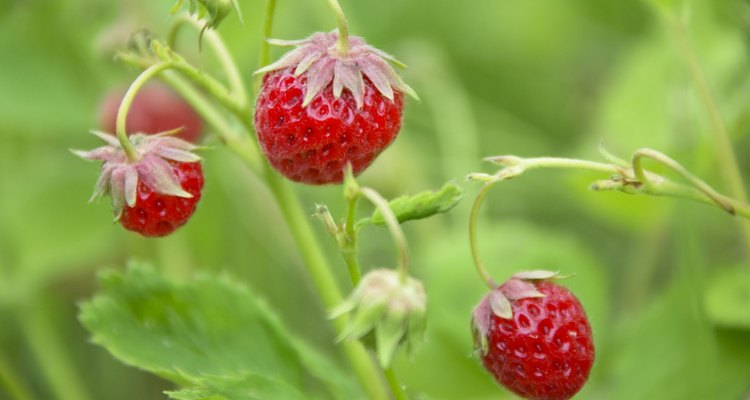
IDC/amanaimagesRF/amana images/Getty Images
The gray mold fungus is the main cause of mold in strawberries (Fragaria x ananassa). Gray mold, Botrytis cinerea, usually affects strawberries growing in cold or damp conditions and it makes them inedible. Contact with decayed plant material also helps spread gray mold. Strawberries grow in U.S. Department of Agriculture plant hardiness zones 2 through 11, depending on the variety. Buying new, disease-free plants every year helps reduce problems with mold.
Causes of Mold
Mold overwinters in plant debris and on living plants that carry the disease, and infects strawberries when conditions are right. Ripe, red strawberries or unripe green strawberries can suffer from mold, but the fungus most quickly affects ripening fruit.
Contact with soil, dead leaves and infected fruit spreads the mold fungus. Fungus spores can also spread through people touching infected fruits and then healthy fruits, and on the wind. Gray mold develops when temperatures are between 70 and 80 degrees Fahrenheit. Wet weather, high humidity and overhead watering also encourage mold growth. Overfertilizing strawberry plants creates lush, soft growth that's vulnerable to mold attack.
Symptoms of Infection
Strawberries infected with gray mold develop minor symptoms that gradually become worse. Infections often begin under the small leaves surrounding the strawberry stalks. Light brown spots appear, which grow larger and develop gray, dusty mold that covers the whole fruit. Strawberry fruits infected with gray mold usually maintain their shape. Infected fruits don't recover. In unfavorable conditions, such as dry, warm air and good air circulation, the disease progresses slowly. The strawberry plant's eaves and stems usually look normal, though gray mold can spread up strawberry stalks.
Preventing Mold
Avoiding crowding and shady sites and use other =controls help prevent mold in strawberries. Grow strawberry plants 2 feet apart in rows 18 inches apart in open, full-sun sites. Stagger the plants so that they are diagonally opposite in their rows.
Water strawberries with drip irrigation or soaker hoses, and not with a watering can, garden hose or sprinklers. Spread a sheet of woven plastic that allows water to penetrate, or another mulch, between the plants to prevent fruits from touching the soil. Suitable mulches include clean straw, sawdust and paper. Don't fertilize strawberries in spring, but wait until after harvesting the fruits. Apply a 16-16-16 fertilizer at a rate of 1 1/2 pound for each 100 square feet, when the strawberry leaves are dry. Don't allow the fertilizer to touch the leaves.
Removing dead and diseased fruits and foliage also helps prevent gray mold from spreading. Sterilize pruning shears by wiping the blades with a cloth that was dipped in rubbing alcohol, before and after pruning strawberries.
Treating Mold
Regular spraying with a fungicide helps protect strawberries from mold. Put on long pants, a long-sleeved shirt, safety goggles and gloves before spraying strawberries with fungicides.
On a dry, still day in spring, when new growth appears on the strawberries, dilute a fungicide containing 48.9 percent N-trichtoromethylthio~cyclohexene-1,2-dicarboximide at a rate of 2 level tablespoons per 1 gallon of water. One gallon of solution treats 100 square feet of strawberry plants. Spray the plants, covering all plant surfaces, and spray them again every seven days until harvest. Manufacturers' instructions vary from product to product, so always read the product label and follow the instructions. Make sure any product you buy is safe to use on edibles.
Related Articles

How to Take Care of Raspberry Bushes

What Is White Squash?
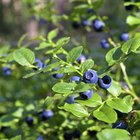
Places to Pick Wild Blueberries in ...
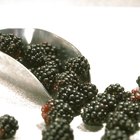
How to Freeze Dewberries

How Are Strawberries Processed?

Are Geraniums Poisonous to Cats?

Can You Eat the Green Stem of a ...

Is an Orange Healthy to Eat for Your ...

What Makes Strawberries Taste Sour?

How to Grow Spider Mums

How to Prevent Bananas From Browning ...
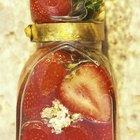
How to Marinate Strawberries

How to Decorate a Cake With Blueberries ...

How to Soften Tomatoes

What Foods Attract Maggots?

How to Avoid Woodpeckers at a ...
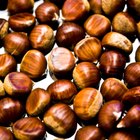
Are Buckeyes & Chestnuts the Same?

The Effects of Organic Fertilizer on ...
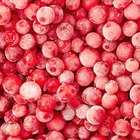
How Long Can You Freeze Fresh ...
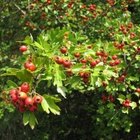
How to Pick Hawthorne Berries
References
Resources
Writer Bio
A graduate of Leeds University, Jenny Green completed Master of Arts in English literature in 1998 and has been writing about travel, gardening, science and pets since 2007. Green's work appears in Diva, Whole Life Times, Listverse, Earthtimes, Lamplight, Stupefying Stories and other websites and magazines.
Photo Credits
IDC/amanaimagesRF/amana images/Getty Images